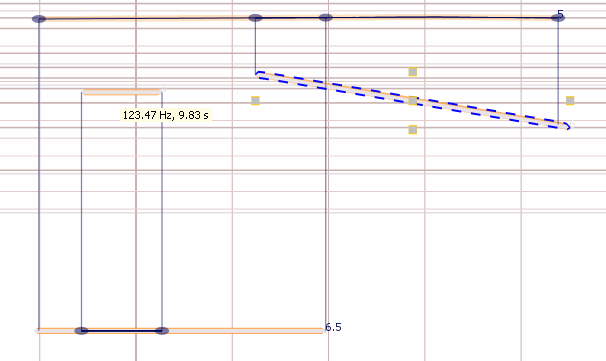
If you tested the low frequency modulation effects on the previous page, you must have been tempted to move the modulator in the audible frequency range already (starting from the last example on the previous page):

What you may have heard at this point is a fairly strange, often metallic sound: the modulator and modulated sounds interfere with one another in the audible range to produce a very rich harmonic spectrum that is the basis for frequency modulation synthesis. The effects are stunning at first, and often appear impossible to master properly.
When the modulating signals reaches audible frequencies (above 20Hz), the modulation effect is not heard anymore as a rapid pulsation of the modulated sounds, but as a change in the tonality or color (waveform) of the original sound. The effect of rapid variations of amplitude or frequencies is to add or remove harmonics to the sound, effectively producing a change of the waveform of the sound.
This section's title is more ambitious than I can afford. So I will stick to two rapid parts:
FM is amazingly powerful. So powerful that it really requires a lot of experience to master it, and it's the reason why the FM synthesizers, such as the DX7, have gone less popular these later years: you really need a degree in math to do what you want with FM.
The base:modulated libray introduces a few "classical" FM instruments, inspired by the Chowning's papers. Those patterns may not be as realistic as possible, because creating very realistic sounds would have resulted in very complex patches that would be hard to understand. Yet, they can serve as a basis to create much more realistic patches. The emulated instruments are: a bell, a generic brass instrument, a clarinet, a bassoon and a violin. Only the violin adds a few more modulation arcs to add some degree of realism to the simple, crude patch. You can use these patches as is, or use the "ungroup" feature to use them as a starting point to create your own FM instruments.
The Wikipedia page on FM synthesis is quite muddy for anyone wanting to get to the bottom of the things. I personnaly recommend the following pages to get to grasp FM modulation:
Following Bill Schottstaedt's conventions, a simple FM modulator in HighC is equivalent to creating a simpleFM: sin(sin) signal. Assigning 2 FM modulators to the same sound (composing) is equivalent to producing a complex FM: sin(sin+sin) signal. Cascading 2 FM modulators in HighC is equivalent to a cascading FM: sin(sin(sin)) signal. To produce the other types of FM modulation that Bill talks about, you may need to resort in HighC to the functional waveforms.